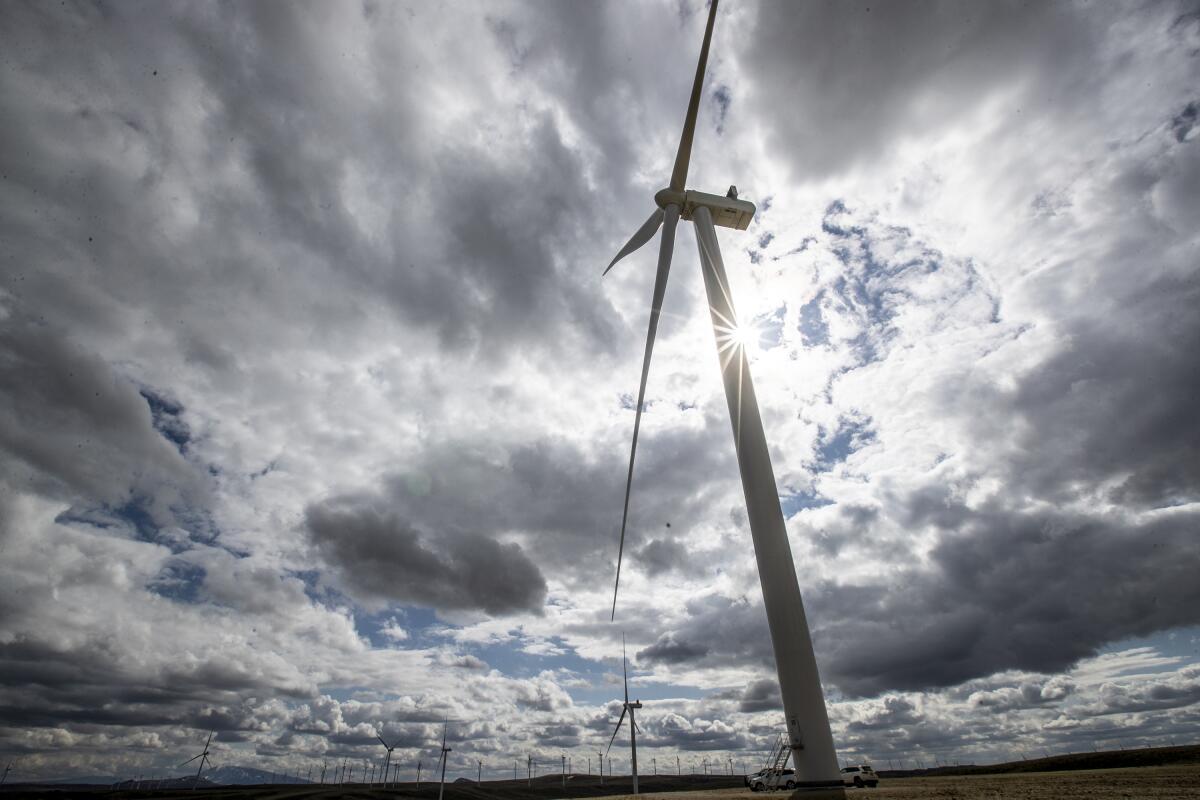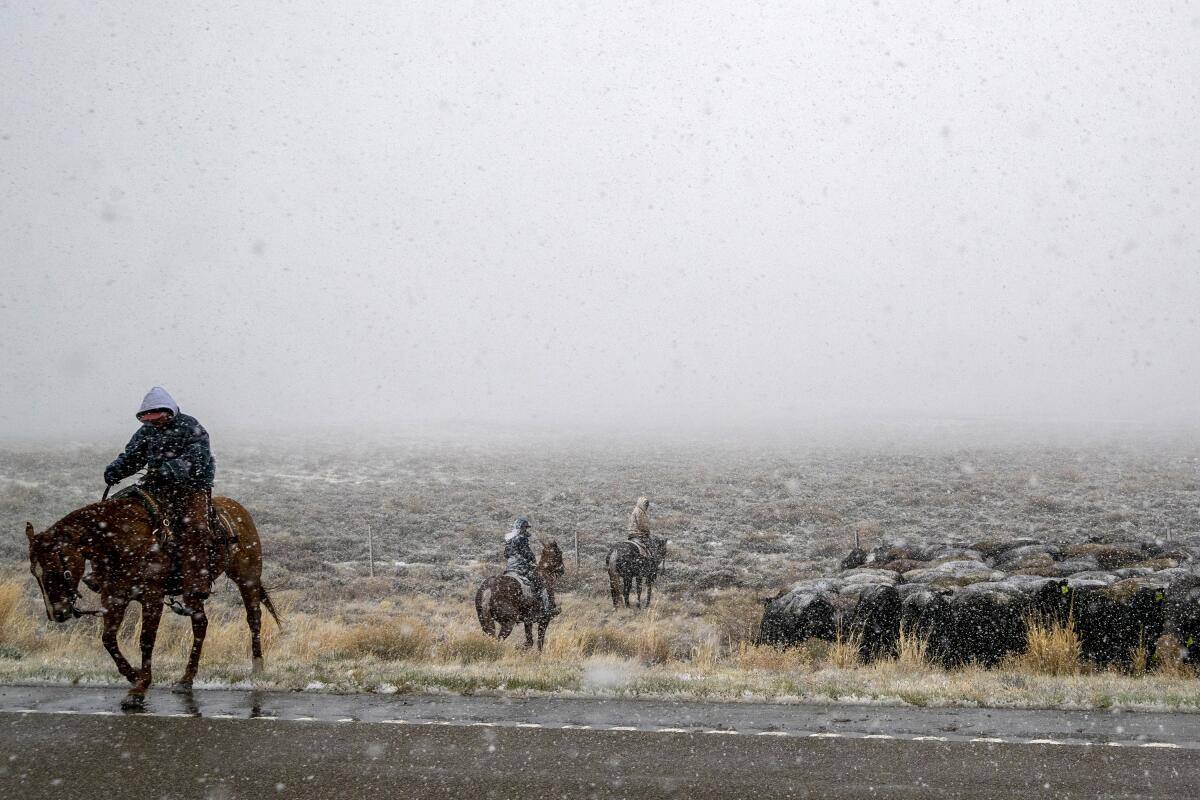Renewable energy is big business. That’s not a bad thing

Good morning, and welcome to the Essential California newsletter. It’s Friday, Aug. 26. I’m Sammy Roth, energy and environment reporter for The Times. I also write our weekly Boiling Point newsletter.
Exploring the American West is one of my favorite pastimes — so when I found an excuse to do it for work, I jumped on it.
This year, I journeyed to Wyoming to tour the construction site of America’s largest wind farm, then drove the planned path of a 732-mile power line that will carry all that clean energy to California. The project is mind-boggling in scope and scale. Workers are clearing pads for about 600 wind turbines on a sprawling cattle ranch slightly larger than the city of Los Angeles. The power line will cross four states, with more than 450 private landowners along the route. The expected price tag is $8 billion.
Sign up for Essential California
The most important California stories and recommendations in your inbox every morning.
You may occasionally receive promotional content from the Los Angeles Times.
[Read “This power line could save California — and forever change the American West,” in The Times.]
The project is a dramatic reminder that renewable energy has become a lucrative business — even in advance of the $369 billion in clean energy incentives embedded in the Inflation Reduction Act signed by President Biden last week. The Wyoming wind farm and power lines are bankrolled by Phil Anschutz, the conservative billionaire and longtime oil baron who owns the Coachella music festival and L.A.’s Crypto.com Arena. He’s far from a climate activist. He’s doing this to make money.
If you care about fighting the climate crisis, that is very much a good thing. The profit motive is a powerful force.
But Anschutz’s wind farm also offers a sneak peek at some of the obstacles that could derail the clean energy revolution — and fuel a future of ever-deadlier wildfires, droughts, heat waves and floods, which are already plenty bad enough.

During my seven days on the road, I met with a biologist who worries about wind turbines killing golden eagles; a rancher who fears Anschutz’s power line will industrialize his rural backcountry; and a National Park Service official who says the power line will interrupt scenic views on the road to a national monument. There are many such conflicts across the West, some of which involve clean power projects threatening sacred Native American sites.
Those are not reasons to give up on renewable energy and keep burning coal, oil and gas indefinitely. As I wrote after last year’s Orange County oil spill, there’s little comparison between the harms wrought by fossil fuels and the negative impacts of solar and wind. The Audubon Society, for instance, points out that bird deaths from wind turbines are “significantly less than deaths caused by outdoor cats and building collisions.” Audubon scientists have also found that global warming threatens to drive two-thirds of North American bird species to extinction.
But the reality is that many communities are skeptical of clean energy projects in their backyards. And although that opposition is sometimes prompted by misinformation, I’ve found it’s often rooted in genuine fears. Change is scary. Rural Westerners love their wide-open views, their well-paying fossil fuel jobs, their sage grouse habitat. And they’re willing to fight to protect it.
If big cities such as Los Angeles want to make sure the wind and solar farms they so desperately need actually get built — and get built fast enough to slow the climate crisis — they’ll have no choice but to work with their critics, and find ways to make the energy transition work for the people on the other end of all those power lines.
It’s a difficult road to navigate — but not an impossible one. As I wrote in this week’s Boiling Point newsletter, there are plenty of opportunities to build bridges and seek out middle ground. There’s never going to be a clean energy project with zero opposition and zero consequences. But it’s possible to limit the damage and build local support.
With the planet hurtling toward catastrophe, we’ve got no choice but to figure it out.
[Read “This power line could save California — and forever change the American West,” in The Times.]
And now, here’s what’s happening across California:
Note: Some of the sites we link to may limit the number of stories you can access without subscribing.
You may be driving your last gas car. At Gov. Gavin Newsom’s urging, California regulators on Thursday banned the sale of most new gasoline-fueled vehicles starting in 2035. Thirty-five percent of newly sold cars will need to be electric, plug-in hybrid or hydrogen-powered by 2025, with the number rising to 68% by 2030 and 100% by 2035. Cars and trucks are the state’s biggest source of planet-warming pollution, so this rule could go a long way toward stemming the climate crisis. Los Angeles Times
Steep, icy and vicious. If you’re thinking about climbing Mt. Shasta, please take the training seriously, and only do it if you’re truly prepared. My colleague Jack Dolan wrote a gripping story about a recent attempt to summit that turned deadly — and the controversial climbing practice that critics say gives a false sense of security to amateur climbers. Los Angeles Times
L.A. COUNTY STORIES
Even more racist texts from Torrance cops. Eight months after a Times investigation revealed racist and homophobic messages exchanged by at least a dozen Torrance police officers, more damning texts are coming to light in court records. Already, at least 113 cases in which officers linked to the scandal were involved in arrests or would have served as material witnesses have been dismissed by city and county prosecutors. Los Angeles Times
Take your kids to the library for some active education. Los Angeles County is using federal COVID-19 relief funds to expand childhood educational programs at a dozen libraries, including several branches in low-income, under-resourced communities. The programs include story time, robotics, 3-D printing and connecting young learners to peer tutors. LAist
Support our journalism
CLIMATE AND ENVIRONMENT
Agriculture accounts for 80% of the Golden State’s water consumption. But many Californians say they have no idea whether farmers are doing enough to save water — even as they’re urged to cut back on their own water use at home. That’s one of several interesting findings from a survey of registered voters co-sponsored by The Times. Seventy-one percent of respondents described the state’s climate-fueled water shortage as “extremely serious.” Los Angeles Times
A settlement in last year’s Orange County oil spill. The Texas company whose undersea pipeline spewed 25,000 gallons of crude into the Pacific Ocean in October has tentatively agreed to settle more than a dozen lawsuits brought by business owners and local residents who say they were harmed by the spill, including a surf shop, a bait and tackle store and several seafood companies. Amplify Energy declined to reveal the settlement terms. Los Angeles Times
POLITICS AND GOVERNMENT
The unintended consequences of an affordable housing law. Senate Bill 1079 was supposed to make it easier for California nonprofits to buy homes that have been foreclosed and keep them affordable. But in many cases, deep-pocketed private investors have partnered with nonprofits to flip those houses instead. One out-of-state nonprofit flipped dozens of foreclosed California homes to help fund its community programs in Virginia. KQED
Fellow campers, say goodbye to propane canisters. Or at least to some of them, at least. A bill awaiting signature from Gov. Gavin Newsom would ban the sale of single-use, 1-pound propane canisters often used to fuel camp stoves or lanterns. They pile up by the tens of thousands in Yosemite National Park and other outdoor hot spots, creating a hazardous waste mess. But don’t worry — those little isobutane canisters for single-burner stoves will still be allowed. San Francisco Chronicle
HOORAY FOR HOLLYWOOD
Welcome to the Courthouse California. That is my lame intro to a wild story by Nate Rogers about the legal drama surrounding the original handwritten lyrics to “Hotel California,” the Eagles hit that even those of us born in the 1990s have learned to love. The Eagles’ Don Henley says the lyric sheets were stolen decades ago, and three individuals have been indicted for trying to auction them off — including a top official at the Rock & Roll Hall of Fame. Los Angeles Times
Reliving a Hawaiian roller coaster ride. Somehow it’s been 20 years since “Lilo & Stitch” hit theaters. I loved this piece by my colleague Christi Carras on the Hawaiian children’s choir that sang the film’s most iconic songs, and how the experience changed their lives for the better. “It made me feel really proud to be able to have this full Hawaiian song be the opening song.... To be able to share our culture and our language was a really powerful thing,” one choir member said. Los Angeles Times
Our daily news podcast
If you’re a fan of this newsletter, you’ll love our daily podcast “The Times,” hosted every weekday by columnist Gustavo Arellano, along with reporters from across our newsroom. Go beyond the headlines. Download and listen on our App, subscribe on Apple Podcasts and follow on Spotify.
CALIFORNIA CULTURE
Good riddance, Arte Moreno. So writes lifelong Orange Countian Gustavo Arellano on the Los Angeles Angels owner, who may soon sell the team: “You could’ve been a somebody, in a region that sorely needed it. Instead, you leave my beloved Anaheim in political ruins and the Angels a joke. May you take your sombrero of shame on the way outta here.” Los Angeles Times
Who is Disneyland for, anyway? The theme park is beloved by generations of Southern Californians, but top executives at Walt Disney Co. have been trying to make the park less accessible to locals — and more accessible to out-of-town visitors, who tend to spend more on hotels and food relative to annual passholders. All of which leads theme park journalist Robert Niles to pose the question: “What does Disney management expect from Disneyland?” Orange County Register
Free online games
Get our free daily crossword puzzle, sudoku, word search and arcade games in our game center at latimes.com/games.
CALIFORNIA ALMANAC
Los Angeles: Partly cloudy, 77. San Diego: Partly cloudy, 78. San Francisco: Partly cloudy, 69. San Jose: Partly cloudy, 83. Fresno: Sunny, 103. Sacramento: Partly cloudy, 96.
AND FINALLY
Today’s California memory is from David Carleton:
In 1958, when I was 9 years old, the Dodgers came to town. They played in the Coliseum for four years while Dodger Stadium was being built. Back then, Los Angeles had a great streetcar system. The bright yellow cars ran on tracks in the middle of the street. To get on or off, you had to dodge traffic. My friends and I went to the Coliseum on the streetcar. We boarded the P Car at Pico and Alvarado. We rode to Vermont where we transferred to the V Car, which dropped us off in front of the Coliseum. Life was good.
If you have a memory or story about the Golden State, share it with us. (Please keep your story to 100 words.)
Please let us know what we can do to make this newsletter more useful to you. Send comments to [email protected].
Sign up for Essential California
The most important California stories and recommendations in your inbox every morning.
You may occasionally receive promotional content from the Los Angeles Times.




